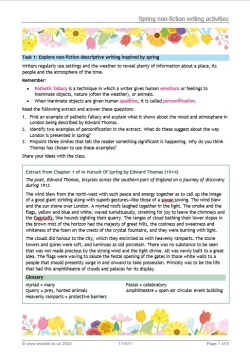Spring non-fiction writing activities
An engaging and creative set of activities for students in both KS3 and KS4 who are exploring key elements of non-fiction and descriptive writing. Students can examine extracts from a non-fiction piece 'In Pursuit Of Spring' by Edward Thomas and identify important techniques alongside meaning.
Students are then guided through a selection of creative and descriptive tasks to help them develop their writing and descriptive skills, including colour coding and visual planning.
There is an answer sheet for the first set of questions included with this resource.
An ideal resource for students who are preparing for the writing section of GCSE English Language Paper 1 and for non-fiction reading analysis for GCSE.
Browse additional resources in the Writing non-fiction section.
A sample extract from the resource:
Writers regularly use settings and the weather to reveal plenty of information about a place, its people and the atmosphere of the time.
Remember:
- Pathetic fallacy is a technique in which a writer gives human emotions or feelings to inanimate objects, nature (often the weather), or animals.
- When inanimate objects are given human qualities, it is called personification.
Read the following extract and answer these questions:
- Find an example of pathetic fallacy and explain what it shows about the mood and atmosphere in London being described by Edward Thomas.
- Identify two examples of personification in the extract. What do these suggest about the way London is presented in spring?
- Pinpoint three similes that tell the reader something significant is happening. Why do you think Thomas has chosen to use these examples?
Share your ideas with the class.
Task 3: Create ideas about spring
Use the space below to make a connection chart about spring.
Begin with all the ideas that come to mind when you think of spring. It could be about the weather, places you go when the season changes, activities or sports you like to take part in, or special days out with family or friends.
Once you have completed your own spring connection chart, share with your partner to see if you can add more ideas and links to enrich your original chart.
When you are finished, share with your class.

